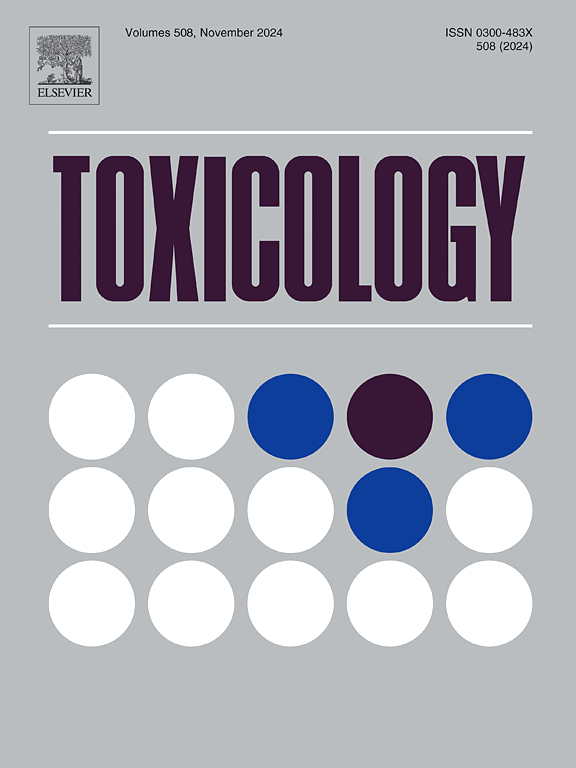miR-144-3p抑制介导发育性砷暴露小鼠诱导的Nrf2激活。
IF 4.6
3区 医学
Q1 PHARMACOLOGY & PHARMACY
引用次数: 0
摘要
发育性砷暴露会增加晚年患肝脏疾病的风险,这与Nrf2激活有关。表观遗传改变被认为有助于Nrf2的激活,但潜在的机制尚未阐明。该研究表明,发育过程中暴露于0.5 ppm砷会导致断奶幼崽肝脏Nrf2活性增加1.5倍,这表明Nrf2及其下游基因过表达。在0.5 ppm砷暴露后,幼崽的血液GSH/GSSG比率增加了4.4倍。Nrf2缺乏可减弱砷诱导的GSH/GSSG比值升高。在发育阶段暴露于砷的幼崽肝脏中,DNA甲基化在整体水平和Nrf2启动子区域没有显著改变。暴露于0.5 ppm砷后,幼崽肝脏中的miR-144-3p和miR-27a-3p水平分别显著降低至对照组的40%和70%。在0.5 ppm砷暴露下,幼崽肝脏中的miR-101a-3p和miR-155-5p水平分别显著增加到对照的2.2和1.8倍。值得注意的是,转染miR-144-3p抑制剂显著增加了原代小鼠肝细胞中Nrf2(2.2倍)及其靶基因Gsr(1.8倍)、Gclc(1.5倍)和Gclm(2.0倍)的mRNA水平。综上所述,我们的数据表明,发育性砷暴露通过抑制miR-144-3p诱导Nrf2的激活。本文章由计算机程序翻译,如有差异,请以英文原文为准。
miR-144-3p suppression mediates Nrf2 activation induced by developmental arsenic exposure in mice
Developmental arsenic exposure enhances the risk for hepatic diseases in later life, which has been found to be related to Nrf2 activation. Epigenetic alterations are suggested to contribute to Nrf2 activation but the potential mechanism is to be elucidated. This study reveals that developmental exposure to 0.5 ppm arsenic induced a 1.5-fold increase in hepatic Nrf2 activity in weaned pups, as indicated by over-expression of Nrf2 and its downstream genes. Blood GSH/GSSG ratio showed a 4.4-fold increase in pups after 0.5 ppm arsenic exposure. Nrf2 deficiency attenuated arsenic-induced GSH/GSSG ratio elevation. DNA methylation at the global level and Nrf2 promoter region was not significantly altered in the liver of pups exposed to arsenic during the developmental stage. The levels of miR-144-3p and miR-27a-3p in the liver of pups were significantly decreased to 40 % and 70 % of control by 0.5 ppm arsenic exposure, respectively. The levels of miR-101a-3p and miR-155-5p in the liver of pups were significantly increased to 2.2 and 1.8-fold of control by 0.5 ppm arsenic exposure, respectively. Notably, transfection with a miR-144-3p inhibitor significantly increased mRNA levels of Nrf2 (2.2-fold) and its target genes Gsr (1.8-fold), Gclc (1.5-fold), and Gclm (2.0-fold) in primary mouse hepatocytes. Taken together, our data suggest that developmental arsenic exposure induced activation of Nrf2 via miR-144-3p suppression.
求助全文
通过发布文献求助,成功后即可免费获取论文全文。
去求助
来源期刊

Toxicology
医学-毒理学
CiteScore
7.80
自引率
4.40%
发文量
222
审稿时长
23 days
期刊介绍:
Toxicology is an international, peer-reviewed journal that publishes only the highest quality original scientific research and critical reviews describing hypothesis-based investigations into mechanisms of toxicity associated with exposures to xenobiotic chemicals, particularly as it relates to human health. In this respect "mechanisms" is defined on both the macro (e.g. physiological, biological, kinetic, species, sex, etc.) and molecular (genomic, transcriptomic, metabolic, etc.) scale. Emphasis is placed on findings that identify novel hazards and that can be extrapolated to exposures and mechanisms that are relevant to estimating human risk. Toxicology also publishes brief communications, personal commentaries and opinion articles, as well as concise expert reviews on contemporary topics. All research and review articles published in Toxicology are subject to rigorous peer review. Authors are asked to contact the Editor-in-Chief prior to submitting review articles or commentaries for consideration for publication in Toxicology.
 求助内容:
求助内容: 应助结果提醒方式:
应助结果提醒方式:


